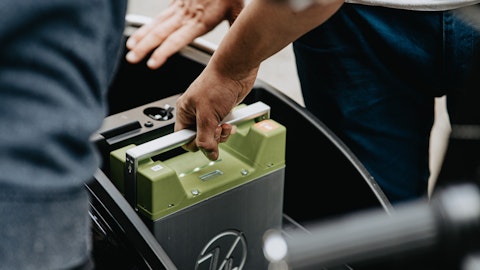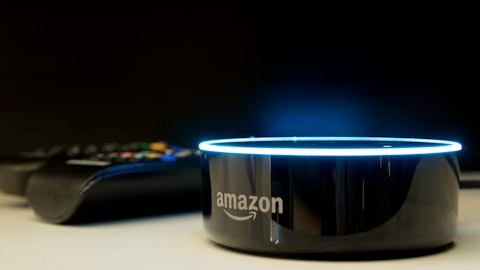George Oliver: Thank you, Josh.
Operator: Our last question we have Gautam Khanna from Cowen. Gautam, your line is open.
Gautam Khanna: Hey, good morning, guys.
George Oliver: Good morning.
Olivier Leonetti: Good morning.
Gautam Khanna: I was wondering if you could talk about any differences you’re seeing in this forward pipeline, order pipeline between Fire & Security and the applied HVAC market. I remember back when you had your Investor Day, you thought those markets would grow at a similar rate. And is that consistent with what you’re seeing today?
George Oliver: Yes. So on the Fire & Security, we are seeing strength in the €“ with the Dodge construction and the activity coming through, and we’re positioned well on that on the €“ more on the retrofit side, we thrive and from a service standpoint and how we upgrade and ultimately reconfigure indoor space and the like. And we’re seeing a lot of that given the hybrid work and how people are coming back to work. And so that is €“ those are the factors that drive Fire & Security. We were up both orders and revenue up close to double-digit in both typically a little bit lower growth rate than what we see in HVAC. And then HVAC is really being driven by what we’ve discussed here frequently here during today’s call around the value proposition not only with the efficiency that we bring within the new equipment but the deployment of heat pumps, for instance.
We are in a situation where we’ve improved our technology with the temperatures that we can generate. When you take a chiller and convert to a heat pump and then be able to replace a boiler, significantly reduces the carbon footprint for our customers. At the same time, you’re getting 3 to 5 times the efficiency out of the unit. And so you get a tremendous payback. And so it’s through these models, Gautam, that as we begin to unleash what we believe to be a very attractive market and does play to our strengths, that is going to be a different demand cycle than what historically we’ve seen in HVAC.
Olivier Leonetti: One statistic, Gautam, to complement what George has indicated, our adjusted pipeline growth today is in the mid-teens, just reflecting what George has indicated.
Gautam Khanna: Okay. And then could you comment on your updated expectations for commodity inflation or deflation, I should say, this year? And then if you could just also comment on lead times that you guys are quoting in the applied commercial HVAC space. Thank you.
George Oliver: Yes. So on the inflation as it relates to commodities, we’re watching that closely. Certainly, some of that has moderated. But as they’ve moderated, other costs have continued to increase. So that’s something we’re watching closely. And certainly, I want to make sure that we stay disciplined with the impact that, that might have. I think what’s important to us now is that the business proposition here is that we’re creating value not necessarily tied to purely price cost as what historically we would have done. So I think that’s one factor. And then the second on the €“ the second was on the applied €“ what was
Gautam Khanna: The lead times.
George Oliver: The lead times as a result of the strong demand, you’ve got to realize, Gautam, that as we’ve gone through the last year, we’ve had significant pickup in our backlog around applied. And so on a go-forward basis, it’s important that we get €“ we’ve been building our capacity. We were expanding a number of our plants, whether it be water cooled chillers or air cooled chillers or industrial refrigeration. Our data center solutions, we’re significantly increasing our capacity as we’ve been ramping up, and we’ve been doing this in line with the supply chain recovery that we’ve been executing on. And so once €“ with this backlog, we’re trying to address the backlog so that we can open up capacity with shorter lead times to now be able to capitalize on what we see to be very strong demand going forward.
So the lead times are being reduced. They’re not to where we like them to be. But with the additional capacity we’re putting online as we go through the year, we’re going to be positioned very competitively from a lead time to be able to respond ultimately and support the customer demand that we see.
Gautam Khanna: Can you give us what the lead times are today? What is it in like 9 months to 12 months? What do you think of it?
George Oliver: They vary. So it’s hard to state any one, depending on the right from the residential to the large commercial, but we’ve been reducing them significantly here over the last six months. We are now with the additional capacity coming on board, I would tell you, our volumes in our applied business on a run rate basis with our chillers and then our water cooled chillers and our air cooled chillers, we’re looking at volumes on a run rate basis that are going to be 2 or 3 times. And so as we’re putting those that capacity in place, it does give us an opportunity on a forward-looking basis to reduce the lead times that we’re quoting to our customers.
Gautam Khanna: Thanks, guys.
George Oliver: Thanks, Gautam.
Operator: That was our final question for today. I will now turn the call back over to the speakers for final comments.
George Oliver: Yes. And I’d like to thank everyone once again for joining us on today’s call. As we have discussed, we have a very strong start to the fiscal year. I’m very confident in our ability to execute and continue the momentum in the coming quarters as we step €“ really step up into the next phase of our digital transformation journey. And with that, I look forward to seeing many of you over the conferences over the next couple of €“ next month or so. And with that, operator, that concludes our call.
Operator: That concludes the call. Thank you for participating. You may disconnect at this time.
Follow Johnson Controls Inc (Old Filings) (NYSE:JCI)
Follow Johnson Controls Inc (Old Filings) (NYSE:JCI)
Receive real-time insider trading and news alerts





